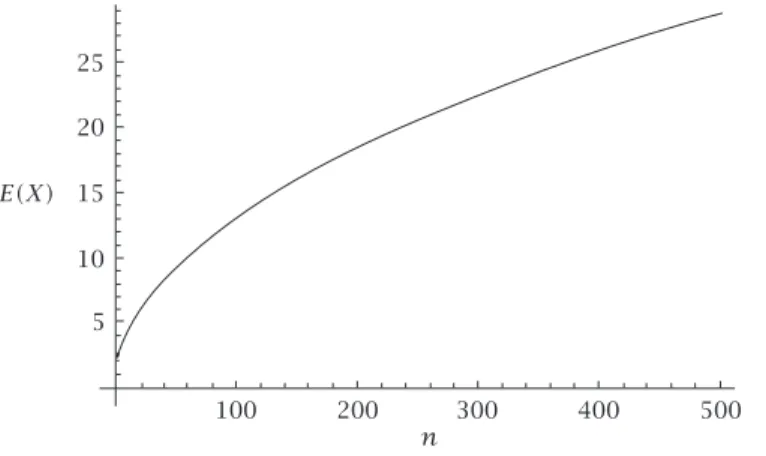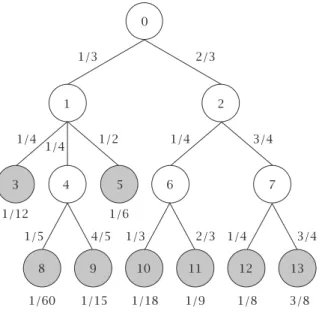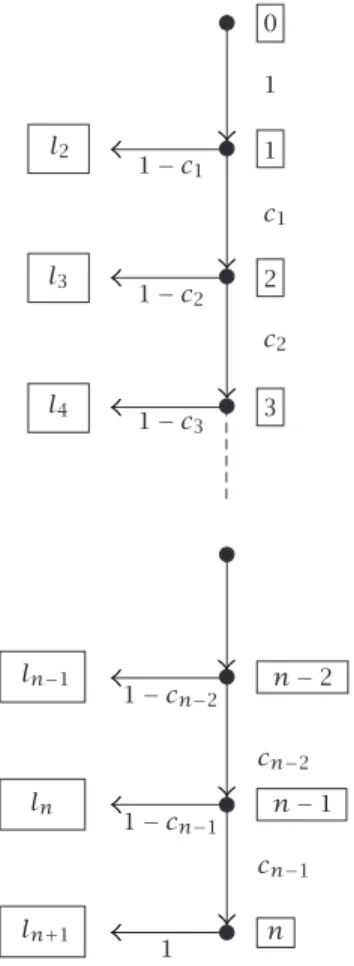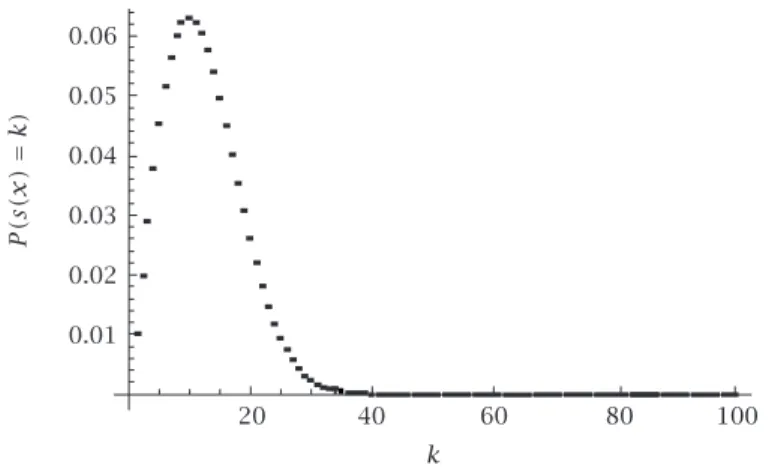PII. S0161171203110101 http://ijmms.hindawi.com © Hindawi Publishing Corp.
ON THE BIRTHDAY PROBLEM: SOME GENERALIZATIONS
AND APPLICATIONS
P. N. RATHIE and P. ZÖRNIG
Received 3 October 2001
We study the birthday problem and some possible extensions. We discuss the uni-modality of the corresponding exact probability distribution and express the mo-ments and generating functions by means of confluent hypergeometric functions U(−;−;−)which are computable using the software Mathematica. The distribu-tion is generalized in two possible direcdistribu-tions, one of them consists in considering a random graph with a single attracting center. Possible applications are also in-dicated.
2000 Mathematics Subject Classification: 60C05, 05A10, 05C05.
1. Introduction. In the present paper, we study the birthday problem which may be formulated in various manners: consider, for example, a smoker who draws matches from a matchbox that contains initiallyn(unused) matches. Whenever he needs a match, he draws one at random and returns the used match into the box. He continues drawing matches until a used one is en-countered for the first time. The probabilitypk(n)that the first used match is encountered in thekth draw is given by (see, e.g., [5, equation (7.1), page 47])
pk(n)=(nn!(k−1)
−k+1)!nk fork=2, . . . , n+1. (1.1)
Forn=365, (1.1) represents the probability that amongkpersons can be found two persons with the same birthday (in this case the matches correspond to the 365 days of the year).
The distribution (1.1) also plays an important role in the study of character-istics of random mappings (random graphs): we consider a random mapping
T of a finite setX= {1,2, . . . , n}into itself, assuming thatT assigns indepen-dently to eachx∈Xits unique imagey∈Xwith probability 1/nfor ally∈X. Denote byGthe directed graph with vertex setX, containing an arrow fromx
toyif and only ifT (x)=y. The set of successors of the elementx∈XinT
is defined as
whereT0(x)=x andTk(x)=T (Tk−1(x))fork≥1. Denoting bys
T(x)the number of elements inST(x), the probability that a vertexxhasksuccessors is given by
P
sT(x)=k= (n−1)!k
(n−k)!nk =p (n)
k+1 (1.3)
(see [8, equation (3.2), page 1047]).
The distribution (1.1) and diverse extensions have been intensively studied (see, e.g., [1,3,4,5,7,8,10,11,12,13,17,20,21,22,23,24,25,26,27]).
In the next section, we study some basic properties of distribution (1.1) and indicate possible applications. Moments and generating functions are deter-mined inSection 3, using the well-knownU-function. InSection 4, we study a very general type of distribution defined by means of directed weighted trees, which generalizes (1.1). Among others, these results yield a recurrence relation for the moments of distribution (1.1). InSection 5, we generalize (1.1), consid-ering the distribution of the number of successors in a random graph with a single attracting center.
2. Some basic properties of the distribution. The following proposition proves that the distribution in (1.1) is unimodal. (To simplify the notation, we writepkinstead ofpk(n)in the following.)
Proposition2.1. The probabilitiespksatisfy
p2<···< pk0≥pk0+1>···> pn+1, (2.1)
wherek0is the smallest integer greater than or equal to1/2+
n+1/4. Moreover,pk0=pk0+1if and only if1/2+n+1/4is an integer.
Proof. We havepk−1< pkif and only if
n!(k−2) (n−k+2)!nk−1<
n!(k−1)
(n−k+1)!nk. (2.2)
Multiplying this inequality by(n−k+2)!nk/n! results in the equivalent condi-tion(k−2)n < (k−1)(n−k+2)which can be written ask2−3k−(n−2) <0 or
k <3/2+
n+1/4. Hence,pk−1< pkifk≤k0. Analogously, we getpk> pk+1
fork≥k0if 1/2+
n+1/4 is not an integer. If this number is an integer, we getpk0=pk0+1andpk> pk+1fork≥k0+1.
Beyond the indexk0above it is interesting to determine the indexk1(k1≥
k0)which maximizes the difference
∆k=pk−pk+1=
(n−1)!
(n−k+1)!nk
k2
−k−n
This index is an equivalent to a turning point of a distribution in the continuous case. Similar to the above consideration, it can be shown that∆k<∆k+1if
(3n+1)k−k3−n (2.4)
is positive and that∆k>∆k+1if (2.4) is negative. We get the following
propo-sition.
Proposition2.2. The indexk1is the smallest integerk such that (2.4) is
nonpositive.
For large numbersn, the indicesk0andk1satisfyk0≈√nandk1<
√ 3n
(see (2.4)), that is, there is an increasing degree of antisymmetry. Ifnconverges to∞,pk0(and thus allpk) converges to 0 since for largen,
pk0=
n! k0−1
n−k0+1!nk0 =
n···
n−k0+2
nk0
k0−1
≤n
k0−1
nk0
k0−1=k0−
1
n ≈
1 √
n.
(2.5)
The distribution (1.1) might have practical applications. Among others, it could be useful to estimate the size of a population. Suppose, for example, that biologists want to estimate the number of fishes of a certain species in a lake. They could proceed as follows: catching a fish repeatedly, mark it every time and put it back into the water. The numberkof fishes (of the considered species) that had to be caught until the first marked fish was encountered represents the test statistics. Letndenote the (unknown) size of the fish pop-ulation, the observed valuekoccurs with probabilitypk(see (1.1)). By means of the maximum likelihood method, the number of fishes can be estimated by the value ofnthat maximizespk(kfixed).
Example2.3. We assume thatk=101; for example, when the 101th fish is caught, a previously marked fish is encountered for the first time. This event occurs with probability
p101(n)=
(n−1)!100
(n−100)!n100 (2.6)
ifndenotes the size of the fish population. Generally,p(n)k is a unimodal func-tion innfor every fixedkand
p(nk+1) pk(n) =
n n+2−k
n
n+1
k−1
that is,
pk(n+1)(≷)p(n)k ⇐⇒n n +2−k
n
n+1
k−1
(≷)1. (2.8)
This impliesp(1015017)< p(1015016)> p101(5015), that is,p101(n)is maximized forn=5016 which is the estimator for the size of the fish population.
As the above calculations illustrate, the population size is approximately given byn=k2/2 for a sufficiently large population. In this case we have (see
[8, page 1047])
(n−1)!k (n−k)!nk≈
k ne−
k2/(2n)
. (2.9)
The right-hand side of this relation is maximized forn=k2/2 whenkis fixed.
The above method represents an alternative to the estimating procedure for a fish population described in [9, Chapter 14].
Further applications of the probability distribution (1.1) are conceivable in quantitative linguistics, in the framework of testing the hypothesis that there is a tendency in language to repeat already used text elements (see [29]).
3. Moments and generating functions. In order to express the moments we make use of the well-known confluent hypergeometric functionU(r;r+n;x)
defined by (see, e.g., [19, page 116] and [28, page 41])
U(r;r+n;x)= n−1
k=0
r(k)(n−k)(k)
k! x−
k−r, n, r=1,2, . . . , x >0, (3.1)
whereα(k)=α(α+1)···(α+k−1)denotes the rising factorial. Computation of this function is easily done by using the software Mathematica. For themth rising factorial moment(m=0,1, . . . ), we get
E X(m)
=E X(X+1)···(X+m−1)
= n+1
k=2
k(k+1)···(k+m−1) n!(k−1) (n−k+1)!nk
= n+1
k=2
(k+m−1)!
(k−2)!
n!
(n−k+1)!nk
=(mn+1)! n−1
k=0
(k+m+1)!(n−1)!
(m+1)!k!(n−k−1)!nk
=(mn+1)! n−1
k=0
(m+2)(k)(n−k)(k)
k!
1
n k
=(m+1)!nm+1U(m
+2;m+n+2;n).
5 10 15 20 25
100 200 300 400 500
E(X)
n
Figure3.1. The dependence of the meanE(X)onn.
Form=0, we obtain
nU(2;n+2;n)=1, (3.3)
a result which is not readily available in the literature on special functions. For
m=1, we get the mean
E(X)=2n2U(3;n
+3;n). (3.4)
Alternatively,
E(X)= n! nn
n
k=0
nk
k! =nU(1;n+2;n)=
e
n n
Γ(n+1, n), (3.5)
whereΓ(α, x)is the incomplete gamma function [28, page 97]. An alternative exact and asymptotic result for a general case, for the expected number of repetitions necessary for one of the alternatives to occur a certain number of times, was given by Klamkin and Newman [17].
Thus, we get
2nU(3;n+3;n)=U(1;n+2;n), (3.6)
another result not easily available.
The dependence of the meanE(X)onnis illustrated inFigure 3.1. It may be noted that forn=365,E(X)=24,6166.
The variance ofXis given by
V (X)=E X(X+1)
−E[X]− E(X)2
=6n3U(4;n
+4;n)−2n2U(3;n
+3;n)−4n4U2(3;n
The moments about the origin can be calculated using the relation (see [16, page 6])
xn= n
k=0
¯
S(n, k)x(k), (3.8)
where ¯S(n, k)denote the Stirling numbers of the fourth kind. We obtain the
rth moments ofXas a linear combination of the polynomialU(−;−;n):
µ′ r=E
Xr
= r
k=0
¯
S(r , k)E X(k)
= r
k=0
¯
S(r , k)(k+1)!nk+1U(k+2;k+n+2;n).
(3.9)
SinceU(−;−;n) can be expressed as a linear combination of incomplete gamma functions, so is µ′
r in a complicated manner. Dwass [4] considered higher asymptotic moments ofX. Holst [10] commented that moments of order statistics from the gamma distribution can be used to get higher moments.
The central momentsµr are obtained from the relation
µr=E(X−µ)r= r
k=0
(−1)k
r k
µkµ′
r−k. (3.10)
Finally, the probability generating functionP (s)and the moment generating functionMX(t)can be expressed as
P (s)=E sX
= n+1
k=2
pksk= n+1
k=2
n!(k−1)sk
(n−k+1)!nk =nU
2;n+2;n
s
, (3.11)
MX(t)=EetX= n+1
k=2
n!(k−1)etk
(n−k−1)!nk=nU
2;n+2;ne−t
, (3.12)
respectively, and the characteristic function is obtained from (3.12), substitut-ingitfort, wherei=√−1.
4. A general type of distribution. LetT be a directed tree with the root 0 such that all arcs are leaving from the root, that is, 0 is the unique source and
δ−(v)=1 for every vertexv≠0 (δ−(v)denotes the indegree ofv, that is, the number of arcs entering intov). We associate a positive weight with all arcs of
1/60 1/15 1/18 1/9 1/8 3/8 1/5 4/5 1/3 2/3 1/4 3/4
0
1 2
3 4 5 6 7
8 9 10 11 12 13
1/12 1/6
1/4
1/4 1/2 1/4 3/4
1/3 2/3
Figure4.1. Example of a directed weighted tree.
for every vertexv≠0, we definew(v)as the product of the weights of the arcs on the unique path from 0 tov. An example of a directed weighted tree is shown inFigure 4.1, where the vertex weights are only indicated when the vertex is a leaf (represented by shaded circles).
Proposition4.1. For every directed weighted tree of the above type, the weights of the leaves sum up to1.
Then result can be easily proved by induction.
Obviously, every tree of the above type defines a discrete probability dis-tribution when the weights of the leaves are interpreted as the probabilities. We consider now the tree inFigure 4.2with the vertices 0,1, . . . , n,ℓ2, . . . , ℓn+1,
whereℓi, i=2, . . . , n+1, represent the leaves. The weights of the leaves (probabilities) are
pk=
1−c1, fork=2,
c1c2···ck−2(1−ck−1), for 3≤k≤n,
c1c2···cn−1, fork=n+1,
(4.1)
0
1
1
c1
2
c2
3 1−c1
1−c2
1−c3
l2
l3
l4
ln−1
ln
ln+1
1−cn−2
1−cn−1
1
n−2
cn−2
n−1
cn−1
n
Figure4.2. A tree representing a probability distribution.
The moments about the origin of distribution (4.1) can be expressed as
µ′
r=EXr
=2r
1−c1+
n
i=3
c1c2···ci−21−ci−1ir+(n+1)rc1c2···cn−1
=1+ n
i=1
(i+1)r−ir
c1c2···ci−1.
(4.2)
Using (4.2), we finally state some interrelations between the moments about the origin of distribution (1.1). Thus, we obtain
µ′ r=1+
n
i=1
(i+1)r−ir (n−1)!
Alternatively theµ′
r can be written as (see (1.1))
µ′ r=
n+1
k=2
(n−1)!(k−1)kr
(n−k+1)!nk−1 =
n
i=1
(n−1)!i(i+1)r
(n−i)!ni . (4.4)
Definingbi=(n−1)!/(n−i)!ni−1andTr=ni=1biir, relations (4.3) and (4.4) read
µ′ r=1+
n
i=1
(i+1)r−ir bi=1+
n
i=1
r−1
j=0 r j
ijb i=1+
r−1
j=0 r j
Tj, (4.5)
µ′ r= 1 n n i=1
i(i+1)rb i= 1
n n i=1 r j=0 r j
ij+1b
i= 1
n r j=0 r j
Tj+1. (4.6)
Combining (4.5) and (4.6) yields the following recurrence relations forTr and
µ′
r, respectively:
Tr+1=n−r Tr+ r−1
j=0
n r j − r j−1
Tj forr=0,1, . . . ,
µ′
r=(n+1)µ′r−1+Tr−1−Tr forr=1,2, . . . .
(4.7)
For small values ofr, (4.7) gives
T1=n, T2=nT0, T3=2n2−nT0, T4=n(1+3n)T0−3n2,
µ′
1=T0+1, µ2′=T0+2n+1, µ3′=(3n+1)T0+3n+1,
µ′
4=(2n+1)T0+8n2+4n+1,
(4.8)
whereT0can be computed as (seeSection 3)
T0=µ1′−1=E(X)−1=
n!
nn n−1
k=0
nk
k!
=2n2U(3;n
+3;n)−1.
(4.9)
p=(1−q)/(n−1)fory =2, . . . , n(see, e.g., [14, page 191]; related models of random graphs are studied in [2, 15]). The probability that the attracting center 1 hasksuccessors is given by
P
s(1)=k =P
Tr(x)
≠x, T (x), . . . , Tr−1(x) (0< r≤k−1);
Tk(x)=Tj(x)for ajwith 0≤j≤k−1
=(1−q)(1−q−p)(1−q−2p)···
1−q−(k−2)p q+(k−1)p
= q+(k−1)p
k−2
j=0
(1−q−jp).
(5.1)
Since
1−q−jp=p(n−1−j), (5.2)
we get
P
s(1)=k
= q+(k−1)p pk−1
k−2
j=0
(n−1−j)
= q+(k−1)p
pk−1(n−1)!
(n−k)! fork=1, . . . , n.
(5.3)
We now determine the probabilityP (s(x)=k), wherex∈ {2, . . . , n}, that is,x
is not the attracting center. Two cases have to be distinguished depending on whether the attracting center is contained in the successor set or not. In the first case we get, assuming thatTi(x)=1 for a fixedi∈ {1, . . . , k−1},
P
s(x)=k|Ti(x)=1
=(1−q−p)(1−q−2p)··· 1−q−(i−1)p
q[1−q−ip]
··· 1−q−(k−2)p q+(k−1)p
= q+(k−1)p q
k−2
j=1
(1−q−jp)
= q+(k−1)p qpk−2
k−2
j=1
(n−1−j) (see(5.2))
= q+(k−1)p
qpk−2(n−2)!
(n−k)!.
The probability thatxhasksuccessors different from 1 is given by
P
s(x)=k|Ti(x)
≠1 fori=1, . . . , k−1
=(1−q−p)(1−q−2p)··· 1−q−(k−1)p kp
=kp
k−1
j=1
(1−q−jp)
=kppk−1
k−1
j=1
(n−1−j)
=kpk (n−2)! (n−k−1)!.
(5.5)
Finally, we get, forx≠1,
P
s(x)=k =P
s(x)=k|Ti(x)
≠1 fori=1, . . . , k−1
+ k−1
i=1
P
s(x)=k|Ti(x)=1
=kpk (n−2)!
(n−k−1)!+(k−1) q+(k−1)p
qpk−2(n−2)!
(n−k)!
=
(n−k)kp2
+(k−1)q q+(k−1)p
pk−2(n−2)!
(n−k)!.
(5.6)
Rewriting the last term, we get
P
s(x)=k
=
k2p(q−p)+k
np2+q2−2qp
+q(p−q)
pk−2(n−2)!
(n−k) fork=1, . . . , n.
(5.7)
Obviously the two distributions in (5.3) and (5.7) result inp(n)k+1(see (1.1)) for
q=p=1/n.
The dependence of the distributions (5.3) and (5.7) on the choice ofq is illustrated in Figures5.1and5.2forn=100. It is observed that (5.7) has the same unimodal form for allq (0< q <1), while (5.3) is unimodal forq <0,1 and 1/2-modal forq≥0,1.
Using the relation
(n−1)!k (n−k)!nk≈
k ne−
k2/(2n)
for largen, (5.8)
(seeExample 2.3) we obtain
P
s(1)=k
≈ q+(k−1)p
(pn)k−1e−k2/(2n)
, (5.9)
P
s(x)=k ≈
k2p(q
−p)+k np2
+q2
−2qp
+q(p−q) n n−1(pn)
k−2e−k2/(2n)
.
0.005 0.01 0.015 0.02 0.025
20 40 60 80 100
P(
s(
1
)
=
k)
k
Figure5.1. The distribution (5.3) forn=100 andq=0,1 (1/2-modal).
0.01 0.02 0.03 0.04 0.05 0.06
20 40 60 80 100
P(
s(
x
)
=
k)
k
Figure5.2. The distribution (5.3) or (5.7) forn=100 andq=0,1 (unimodal).
For continuous values ofk (k >0), the right-hand sides in (5.9) and (5.10) represent the asymptotic densities of the number of successors of the attract-ing center 1 or a vertexx≠1, respectively.
The results of this section might be interesting in random-number gener-ation. It may be assumed that in the generation of random numbers a se-quencex, T (x), T2(x), . . . is constructed (see, e.g., [6] and [18, Section 3.1]),
wherex∈X= {1,2, . . . , n}andT is a mapping selected at random from all the
nnmappings fromXinto itself.
If all the nn mappings are chosen with equal probability, p(n)
k+1 gives the
Formulas (5.3) and (5.7) give the probability of cycling after k iterations, when mappingsT that assign frequently the image 1 are preferred.
References
[1] G. C. Berresford,The uniformity assumption in the birthday problem, Math. Mag. 53(1980), no. 5, 286–288.
[2] Y. D. Burtin,On a simple formula for random mappings and its applications, J. Appl. Probab.17(1980), no. 2, 403–414.
[3] M. Camarri and J. Pitman,Limit distributions and random trees derived from the birthday problem with unequal probabilities, Electron. J. Probab.5(2000), no. 1, 1–18.
[4] M. Dwass,More birthday surprises, J. Combinatorial Theory7(1969), 258–261. [5] W. Feller,An Introduction to Probability Theory and Its Applications. Vol. I, John
Wiley & Sons, New York, 1964.
[6] P. Flajolet and A. M. Odlyzko, Random mapping statistics, Advances in Cryptology—EUROCRYPT ’89 (Houthalen, 1989) (J.-J. Quisquater and J. Vandewalle, eds.), Lecture Notes in Comput. Sci., vol. 434, Springer, Berlin, 1990, pp. 329–354.
[7] M. H. Gail, G. H. Weiss, N. Mantel, and S. J. O’Brien,A solution to the generalized birthday problem with application to allozyme screening for cell culture contamination, J. Appl. Probab.16(1979), no. 2, 242–251.
[8] B. Harris, Probability distributions related to random mappings, Ann. Math. Statist.31(1960), 1045–1062.
[9] M. Hollander and F. Proschan,The Statistical Exorcist, Marcel Dekker, New York, 1984.
[10] L. Holst,On birthday, collectors’, occupancy and other classical urn problems, Internat. Statist. Rev.54(1986), no. 1, 15–27.
[11] ,The general birthday problem, Random Structures Algorithms6(1995), no. 2-3, 201–208.
[12] L. Holst and J. Hüsler,Sequential urn schemes and birth processes, Adv. in Appl. Probab.17(1985), no. 2, 257–279.
[13] J. Hubert and T. V. Narayana,A note on the birthday problem, Bul. Inst. Politehn. Ia¸si (N.S.)15 (19)(1969), no. 1-2, 113–118.
[14] J. Jaworski,On a random mapping(T , Pj), J. Appl. Probab.21 (1984), no. 1, 186–191.
[15] ,Epidemic processes on digraphs of random mappings, J. Appl. Probab.36 (1999), no. 3, 780–798.
[16] N. L. Johnson, S. Kotz, and N. Balakrishnan,Discrete Multivariate Distributions, Wiley Series in Probability and Statistics: Applied Probability and Statistics, John Wiley & Sons, New York, 1997.
[17] M. S. Klamkin and D. J. Newman,Extensions of the birthday surprise, J. Combina-torial Theory3(1967), 279–282.
[18] D. E. Knuth,The Art of Computer Programming, Vol 2: Seminumerical Algorithms, 3rd ed., Addison-Wesley, Massachusetts, 1998.
[19] Y. L. Luke,The Special Functions and Their Approximations, Vol. I, Mathematics in Science and Engineering, vol. 53, Academic Press, New York, 1969. [20] S. Mase,Approximations to the birthday problem with unequal occurrence
prob-abilities and their application to the surname problem in Japan, Ann. Inst. Statist. Math.44(1992), no. 3, 479–499.
[22] J. Naus,An extension of the birthday problem, Amer. Statist.22(1968), 27–29. [23] ,Probabilities for a generalized birthday problem, J. Amer. Statist. Assoc.
69(1974), 810–815.
[24] J. Riordan,Combinatorial Identities, John Wiley & Sons, New York, 1968. [25] P. F. Rust,The effect of leap years and seasonal trends on the birthday problem,
Amer. Statist.30(1976), 197–198.
[26] B. Saperstein, The generalized birthday problem, J. Amer. Statist. Assoc. 67 (1972), 425–428.
[27] M. Sayrafiezadeh,The birthday problem revisited, Math. Mag.67(1994), no. 3, 220–223.
[28] L. J. Slater,Confluent Hypergeometric Functions, Cambridge University Press, New York, 1960.
[29] P. Zörnig,A theory of distances between like elements in a sequence, Glottometrika 8, Quantitative Linguistics, vol. 32, Brockmeyer, Bochum, 1987, pp. 1–22.
P. N. Rathie: Departamento de Estatística, Instituto de Ciências Exatas, Universidade de Brasília, 70910-900 Brasília, DF, Brazil
E-mail address:rathie@unb.br
P. Zörnig: Departamento de Estatística, Instituto de Ciências Exatas, Universidade de Brasília, 70910-900 Brasília, DF, Brazil



